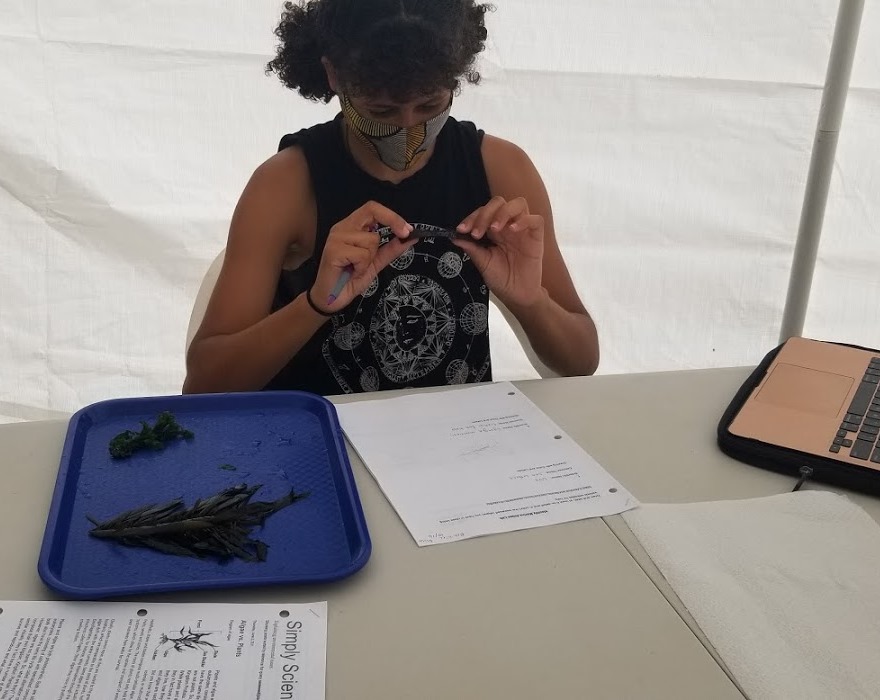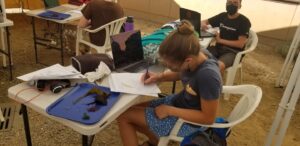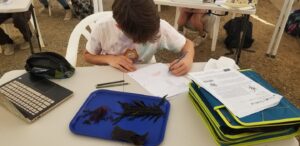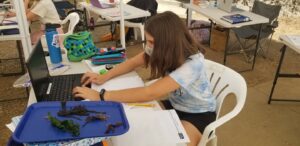 When you can’t go to the beach for marine biology lab in situ, you can bring the lab specimens – in this case, seaweed gathered along a local beach – to school!
When you can’t go to the beach for marine biology lab in situ, you can bring the lab specimens – in this case, seaweed gathered along a local beach – to school!
On a recent morning, Mount Madonna School ninth grade marine biology students, working at physically distanced tables in their outdoor classroom, studied various types of seaweed, plant-like protists also known as algae.
Teacher Nicole Silva asked students to identify several types of seaweed using a dichotomous key website, labeling the anatomy of the various seaweeds, as well as comparing the differences between plants and algae.
“It’s fascinating to me how different all types of seaweed are,” said freshman Ethan Lee. “I’ve seen a lot of them at the beach and I didn’t even consider  them to be seaweed!”
them to be seaweed!”
 “I really loved this lab because you could actually see and feel the different types of seaweeds and algae,” shared classmate Ona Musoll-Buendia. “It was a bit stinky, but worth it in the end! I hope to do more labs like this one.”
“I really loved this lab because you could actually see and feel the different types of seaweeds and algae,” shared classmate Ona Musoll-Buendia. “It was a bit stinky, but worth it in the end! I hope to do more labs like this one.”
Many MMS students have grown up living by the beach, but haven’t necessarily stopped to think about the importance of seaweed to the marine environment and to humans.
“Before this lab, I absolutely didn’t like seaweed and ever since I was little, I’ve had a ‘seaweed phobia’,” commented student Emma Monclus. “This lab showed me that seaweed is very important for the environment, and it has earned my respect.”
“By examining them firsthand, students get to see just how varied and diverse the types of seaweeds are in their own backyard,” said Silva. “Students are surprised to find out how many types there are and that they are not a plant.
“They begin to understand that just like our MMS forest environment with its various types of plants and trees like oaks and redwoods, there is an underwater forest just as varied,” she continued. “There’s an entire ecosystem from microscopic zooplankton to large apex predators such as great white sharks depend on these protists. The students know that trees are vital to producing oxygen for us to breathe, but they are surprised to find out that seaweeds actually account for 70 to 80% of the oxygen we breathe. They begin to understand the importance and significance of algae to our lives, as well as all life in the ocean.”
###
Contact: Leigh Ann Clifton, director of marketing & communications,
Nestled among the redwoods on 375 acres, Mount Madonna School (MMS) is a diverse learning community dedicated to creative, intellectual, and ethical growth. MMS supports its students in becoming caring, self-aware, discerning and articulate individuals; and believe a fulfilling life includes personal accomplishments, meaningful relationships and service to society. The CAIS and WASC accredited program emphasizes academic excellence, creative self-expression and positive character development. Located on Summit Road between Gilroy and Watsonville. Founded in 1979.







